The Right Click Context Menu gives you added functionality by offering you actions you can take with the item. It also lets you create new documents, folders, shortcuts, or items when you select the New context menu. But over time, you may realize that you don’t use most of the items in the New context menu, or you may wish to add some entries. We have already seen how we can add, remove, edit all the Context Menu items in Windows. In this post, we will see how you can edit, add or remove items from New Context Menu in Windows 11/10, using the Registry Editor or freeware to do it easily.
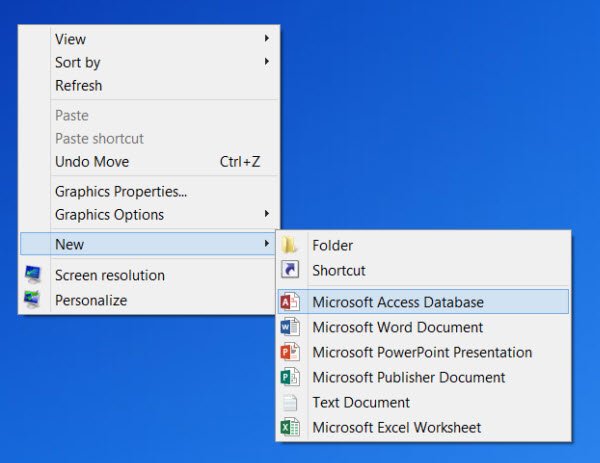
How to Add or Remove items from New Context Menu
You can edit, add, remove, and restore items from the NEW context menu in Windows 11/10 using Registry or freeware.
1] Using Registry Editor
To edit or remove items from New Context Menu, open the Registry Editor and navigate to the following key, and expand it:
HKEY_CLASSES_ROOT
Look for the file-type New item that you would like to remove from the New context menu.
If you want to remove New Word document, you will have to search for .docx key and expand it. Once you have done that, you will have to delete the ShellNew key. This will remove the entry to create a new Word document from the new context menu.
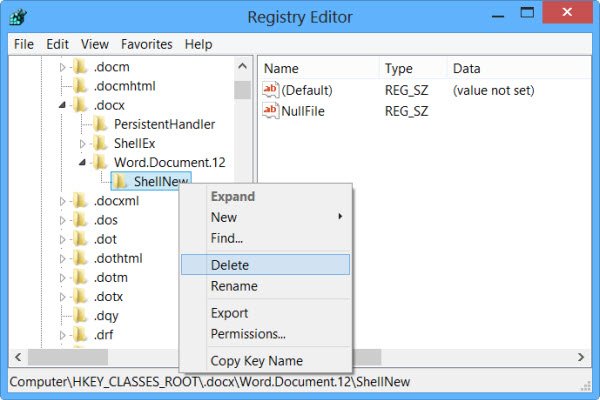
To add an item or file type, search for the file type. Right-click on it and select New > Key and give it the name ShellNew.
Now in the right pane, select New > String Value, name it NullFile and set its value at 1.
2] Using Freeware
ShellNewHandler
You can also disable or remove items from New Context Menu easily using an open-source tool called ShellNewHandler. Simply download this portable tool and run it.
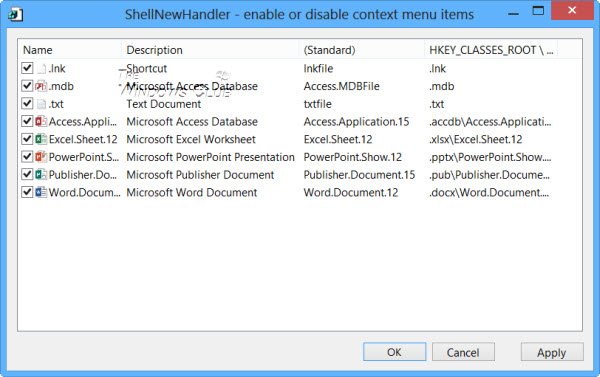
Uncheck the item you want disabled or removed and click Apply. The items will now no longer appear in your New context menu. To enable the item, simply check the box and click App.
New Menu Editor
Another freeware called New Menu Editor lets you remove as well as add new or different items to the New context menu easily.
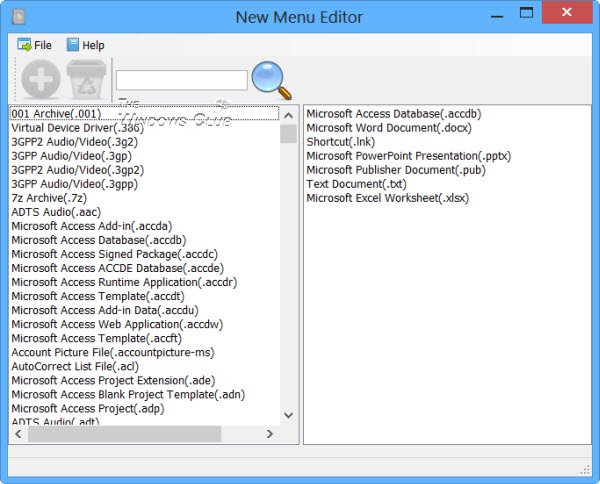
You can download it from its download page on CNET. Remember to click on the small Direct download link there to download only the tool. To add items, select the items in the left pane and click on the Add or + button. To remove items, select items are shown in the right pane and click on the Delete or Thrash button. Do read its Help file for details.
Cleaning the New Context Menu will give you a smaller new menu by removing the items you do not want.
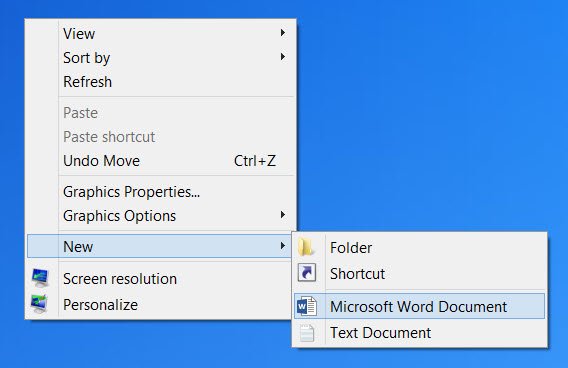
ShellNewSettings
This is another tool you can download.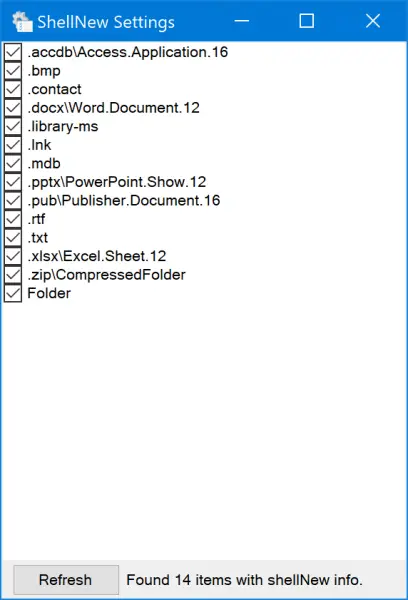
Simply download and run the executable file. If you uncheck any given option in the application, it will remove that particular entry from the context menu. When you select any given option, it will add that particular entry back to the context menu.
TIP: You can also disable items from the New submenu in Explorer context menu with ShellMenuNew.
Restore default NEW context menu items in Windows
If you wish to restore the entire New context menu to Windows 10 default, then first backup your Registry, create a restore point, and then download this registry fix from our servers. Extract its contents and click on the .reg file to add its contents to your Context Menu.
This post will help you if the New Text document item is missing from Context Menu in Windows.
Related posts that may interest you:
- See how you can add a new file type in the New Item of Explorer Ribbon Menu.
- Check this if your NEW context menu is missing in Windows.
- This post will help you if Context Menu freezes or is slow to open.
New Menu Editor helped me put things in order. Thank you very much!
Exactly what I was looking for, thanks!
Very helpful. Thank you. I’ve been looking for this for a long time.
The New Context Menu works, thanks a lot
Does anyone know how to RE-ORDER the New Menu Items? Is there a tool or technique? Thx.
I am looking for some help:
I have introduced a new drop down item called Encrypt at right click to all file types – therefore I had to add it as :
HKEY_CLASSES_ROOT*shellEncrypt
Now this drop down would be visible to all type of files at their right click.
But I also have files of type .crypt
HKEY_CLASSES_ROOTencryptedfile (encryptedfile is defined of type .crypt)
Now I do not want this drop down ‘Encrypt’ to be visible when I right click files of type .crypt
How can this be achieved?
Thank you
The ShellNew Handler, the first one, worked perfect. I downloaded the New Menu Editor too but quit the install as it kept offering to install other items and my system warned me something about changes being made to browser toolbars, been there before, so quit the install, but ShellNewHandler did the job! Thank you!
I used to use TweakUI for this but it doesn’t work with Win7.
It’s in alphabetic order. You can’t.
LOVE THE POST
I can’t find New Menu Editoron cnet.
Your freeware solutions should be up top, they are easiest to use, regedit on bottom.
Thank you.
New Menu Editor did the trick. Easy to use. Registry Editor takes a long time, but works as well.
Ho do i create Readme.doc rather than New Microsoft Word Document by default
Thanks a lot. This Article was very helpful.
New Menu Editor is the only way to go!!!
http://www.freewarefiles.com/downloads_counter.php?programid=77566
I want to ask that if I want to show my context menu only on My document folder than how can I do that. like empty recycle bin context menu only display when we right click on recycle bin thank you. I have tried lots of ways but those are not working..
Windows 10 – ShellNewHandler doesn’t work, destroyed existing entries. Had to use System Restore to fix them.
THis is nice, but already knew…what would be nice is if you could modify the text, icon and automatically open the file that is created with one click in the New menu, since the main reason most users use this is to create a file at a specific location and then open the file to modify it as well. There must be some way since my Win8 system, the “Add Contact” ShellNew key does using a MenuText, IconPath, and Command path strings, but if you try to make these strings in the ShellNew for any other extension I’ve tried, it doesn’t work :(, so possibly these strings are program specific unfortunately. Any advice would be great.
Why doesn’t Microsoft provide such a utility to actually customize and make their operating system more friendly?
In Win10 at least, a modification is needed if manually editing the registry. On “To add an item or file-type, search fo the file-type. Right-click on it and select New > Key and give it a name ShellNew. Now in the right pane, select New > String Value, name it NullFile and set its value at 1.” … should be “…and set its value at
” with nothing in it. Check entries for other known file types to verify what I am saying.